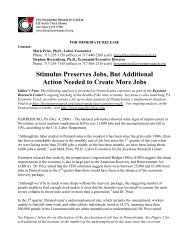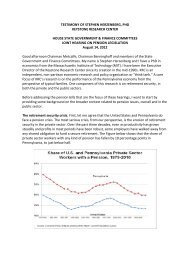The State of Working Pennsylvania 2004 - The Keystone Research ...
The State of Working Pennsylvania 2004 - The Keystone Research ...
The State of Working Pennsylvania 2004 - The Keystone Research ...
You also want an ePaper? Increase the reach of your titles
YUMPU automatically turns print PDFs into web optimized ePapers that Google loves.
<strong>The</strong> <strong>State</strong> <strong>of</strong> <strong>Working</strong> <strong>Pennsylvania</strong> <strong>2004</strong> 26<br />
Wages Rise in Philadelphia and Southern Metro Areas, Fall in Rest <strong>of</strong> <strong>State</strong><br />
Since 1989 wages in metropolitan Philadelphia and southern metropolitan <strong>Pennsylvania</strong> (a region<br />
that combines the metropolitan areas <strong>of</strong> Allentown-Bethlehem-Easton, Reading, Harrisburg-<br />
Lebanon-Carlisle, Lancaster, and York) have increased steadily, even during the 2001 recession and<br />
its aftermath (Table 7). <strong>The</strong> Philadelphia area has always had the highest median wage among the<br />
four regions shown in Table 7. With the exception <strong>of</strong> 2000-2003, the Philadelphia area also had the<br />
fastest rate <strong>of</strong> wage growth during the time periods shown in Table 7. Metropolitan Philadelphia’s<br />
median wage in 2003 was $15.38 per hour, about 13 percent higher than in 1989, about 2 percent<br />
higher than in 2000, and nearly 1 percent higher than in 2002.<br />
Table 7. Median Hourly Wages in Four <strong>Pennsylvania</strong> Regions, 1979-2003<br />
Median Wage Philadelphia<br />
Metro*<br />
Pittsburgh<br />
Metro<br />
Southern<br />
Metro**<br />
Rest <strong>of</strong> <strong>State</strong><br />
1979 $13.22 $14.67 N/A N/A<br />
1989 13.61 11.93 $12.54 $11.46<br />
1995 13.78 12.89 13.07 10.79<br />
2000 15.06 13.14 13.09 11.44<br />
2002 15.24 14.32 13.71 12.27<br />
2003 15.38 14.00 13.75 12.00<br />
Percent change<br />
1979-2003 16.3% -4.6%<br />
1989-2003 13.0 17.3 9.7% 4.7%<br />
1995-2003 11.6 8.6 5.2 11.2<br />
2000-2003 2.1 6.6 5.1 4.9<br />
2002-2003 0.9 -2.2 0.3 -2.2<br />
*Entire Philadelphia PMSA including New Jersey. ** Southern Metropolitan <strong>Pennsylvania</strong> combines the<br />
metropolitan areas <strong>of</strong> Allentown-Bethlehem-Easton, Reading, Harrisburg-Lebanon-Carlisle, Lancaster, and<br />
York.<br />
Source: KRC analysis <strong>of</strong> CPS data.<br />
<strong>The</strong> southern metropolitan region’s wages, although much lower than those in the Philadelphia area,<br />
followed a similar pattern but generally rose less rapidly. This region’s median hourly wage in 2003<br />
was $13.75, nearly 10 percent higher than in 1989, about 5 percent higher than in 2000, and 0.3<br />
percent higher than in 2002.<br />
Metropolitan Pittsburgh and the rest <strong>of</strong> the state seem to have suffered more from the job market<br />
slackness that lingered after the 2001 recession, although their wages were higher in 2003 than in<br />
2000. Wages in those two regions rose steadily from 1989-2002 but then fell in 2003. In 1989 and<br />
1995 metropolitan Pittsburgh had the third-highest median wage among the four regions analyzed<br />
here; after 1995 it moved up to second-highest, outpacing the southern metropolitan region.<br />
Despite wage growth in the 1990s that continued until 2002, metropolitan Pittsburgh has never<br />
recovered from a precipitous $2.74 per hour wage drop that occurred from 1979-1989, a period







